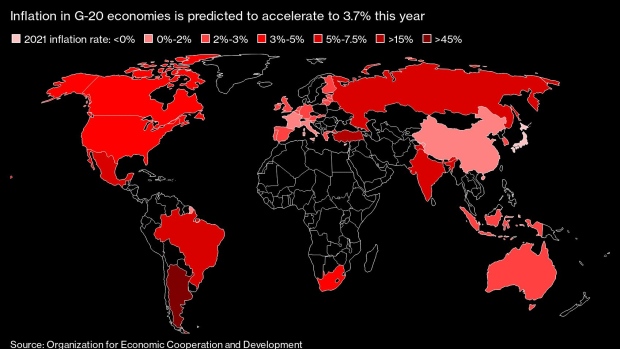Sep 23, 2021
ECB Is Lonelier Than Ever After a Hawkish Turn Led by the Fed
, Bloomberg News

(Bloomberg) -- With central banks from Washington to London this week signaling more alarm over faster inflation, the ultra-stimulative path of the euro zone and some of its neighbors appears lonelier than ever.
A collective move to look beyond the pandemic slump and toward the risk rising of accelerating prices emerged with a warning from the U.S. Federal Reserve that it may taper bond-buying soon, the prospect of higher interest rates as early as this year from the Bank of England and at least five other hikes from central banks around the globe.
That left a clear divergence on policy with the European Central Bank, where officials are still largely more worried about supporting the fragile recovery. They’ve been at pains to insist that a dial-back in stimulus announced on Sept. 9 isn’t the sort of tapering that may soon appear in the U.S.
The pivotal week may set the tone in financial markets for months to come. By December, the Fed might be winding down support and looking toward a rate hike, with other central banks planning their own withdrawals. That’s also when the euro zone will most likely discuss how its own stimulus program should evolve, with another form of bond purchases a likely outcome to combat the region’s endemic economic weakness.
“The ECB expects that problems that persisted before the pandemic will persist for some time, so they need to be far more cautious about removing the punch bowl,” said Neville Hill, chief European economist at Credit Suisse Group AG in London. “It’s going to be much slower than the Fed or the Bank of England.”
While global cost pressures have also boosted inflation in the euro zone, policy makers there remain more sanguine than counterparts. The ECB’s own outlook anticipates an undershoot of its 2% goal over its the forecast horizon.
“The slack is much bigger in Europe,” said Ludovic Subran, chief economist at Allianz SE.
By contrast, several Fed policy makers have cited rapid price increases as a reason to start rate increases as early as next year. Tapering could come as soon as the next meeting in November, Chair Jerome Powell told reporters on Wednesday.
“The U.S. economy doesn’t need large amounts of liquidity any more,” Paul Donovan, global chief economist at UBS Group AG Wealth Management, told Bloomberg Television. “There’s almost a sense of relief that the Fed is getting on with it and going back to normal.”
What Bloomberg Economics Says...
“The hawkish shift in the dot plot suggests that, for now, it’s concern about price stability that is the greater focus of attention for the FOMC.”
--Anna Wong, Andrew Husby and Eliza Winger. To read the report, click here
By comparison, policy is stuck in place at the ECB and its counterparts nearby. In tune with the euro area, Sweden’s Riksbank revealed on Tuesday that it doesn’t envisage a rate increase in the foreseeable future. The Swiss National Bank maintained the world’s deepest sub-zero monetary stance.
Europe’s fellow traveler on this road, the Bank of Japan, kept up its own stimulus in place this week.
Outlining the options for the ECB, Governing Council member Madis Muller told Bloomberg this week that he and colleagues will discuss boosting regular asset purchases once their pandemic-era emergency stimulus comes to an end. One option would be to expand the pre-crisis plan above the current level of 20 billion euros ($23 billion) even though such increase is by no means guaranteed, he said.
Despite such prospects of continued stimulus, Holger Schmieding, the London-based chief economist of Berenberg, cautions that the euro zone isn’t totally diverging from the rest of the world, even if a policy gap now seems apparent.
“They are both moving in the same direction,” he said. “But at a different speed.”
©2021 Bloomberg L.P.